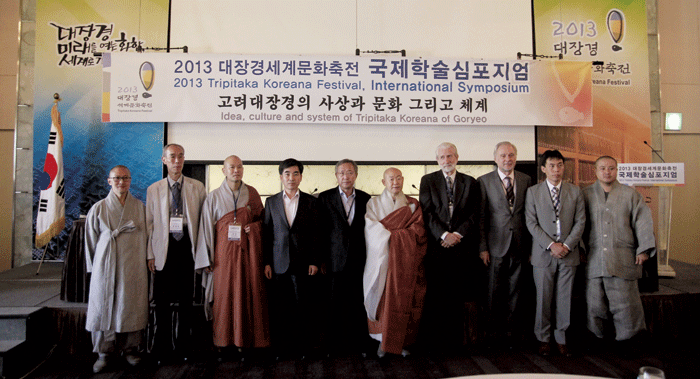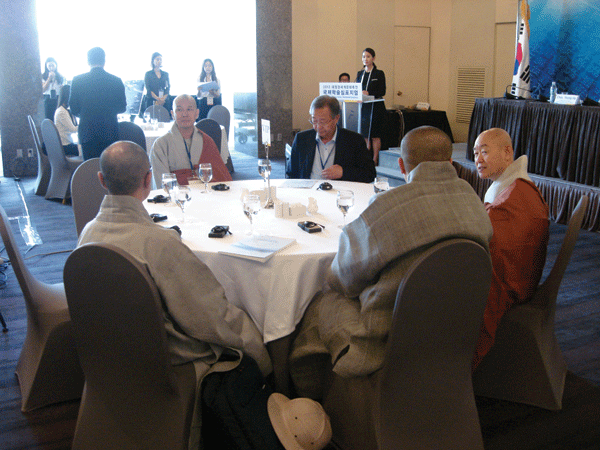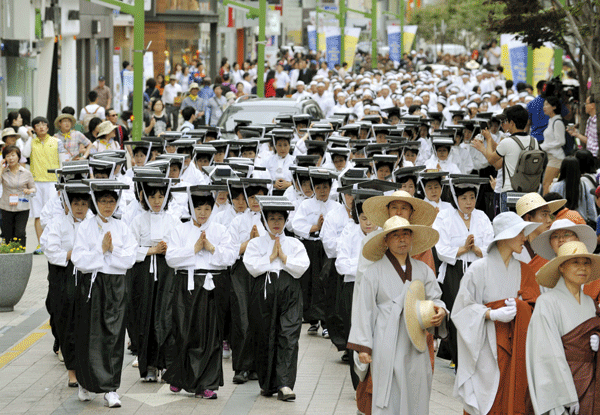LOCAL AUTONOMY
At international symposium in Seoul
Scholars urge academia to launch trans-disciplinary studies on Tripitaka Koreana
Scholars from Korea, the United States and Japan urged academia to launch comprehensive, Trans-disciplinary studies on the world’s oldest wooden canons, consisting of some 1,514 texts carved on 81,258 individual blocks and bundled into 6,815 fascicles at the 2013 Tripitaka Koreana Festival, International Symposium held at the Plaza Hotel in downtown Seoul on Sept. 3, 2013.
The symposium was a preliminary event for a global Tripitaka Koreana Festival, which will be held in Hapcheon, South Gyeongsang Province, from Sept. 27 through Nov. 10 to celebrate the creation of the historic scriptures.

The Tripitaka Koreana is a collection of Buddhist teachings and laws carved on more than 80,000 wooden printing blocks, created in the 13th century. It is considered as the most comprehensive set of Buddhist scriptures found to date, and the Haein-sa Buddhist Temple, where the texts are kept, is a UNESCO World Heritage site.
Speakers at the conference included Lewis Lancaster, an East Asian Studies professor at UC Berkeley, and Robert Buswell, a Korean and Chinese Buddhist Studies professor at UCLA, whose presentations were followed by a panel discussion, according to the organizers.
The Tripitaka Koreana Festival was first held in 2011 to celebrate the millennial anniversary of the canon’s creation.

This year’s festival will offer a wider range of exhibitions and interactive sessions, the organizers said. Five exhibition halls, each with a different theme, will feature historic, cultural and entertainment programs on various topics related to the Tripitaka, they added.
“The Tripitaka Koreana Festival garnered attention as traditional cultural content and an iconic asset in the 21st century,” South Gyeongsang Province Governor Hong Joon-pyo said.
“We plan to prepare and organize the festival with an aim to promote a harmonious encounter and solidarity of mankind through wisdom and harmony.”

During the symposium, Professor Robert Buswell of UCLA asserted that the UNESCO Memory of the World register is the most comprehensive collection of East Asian Buddhist literature compiled up to that time. He suggested that the English name of the cultural heritage be changed to simply “Goryeo Daejanggyeong” in Korean, or Korean Buddhist Canon, instead of using the term Tripitaka.
Ven. Sun hae, chief of Haein-sa Temple, and other high-ranking officials in Korean Buddhism also participated in the International Symposium in Seoul on September 3.
“The ‘Goryeo Daejanggyeong’ is much bigger and larger than the Indian model of Tripitaka. It doesn’t really give a sense of what the Goryeo Canon is,” Professor Robert Buswell said, explaining the production of the set of wooden blocks as an enormous national commitment of money and manpower - perhaps, he claimed, the closest modern comparison being the U.S. missions to the Moon in the 1960s.
The international symposium highlighted lesser-known aspects of the Buddhist canon, encouraging the public to raise their awareness of the 800-year-old cultural heritage item.
Buswell introduced monk- scholar Sugi, who left a work documenting in remarkable detail the process that he and his editorial team followed in compiling his canon.
“Sugi’s notes are even more valuable because they are the only extant record detailing how an East Asian Buddhist scholar in the premodern era went about the task of collating and editing multiple recessions of thousands of scriptures into a definitive canon,” he said.

Professor Baba Hisayuki of Bukkyo University in Japan revealed that the Tripitaka Korea, believed to have been completed at a plant in Namhae, South Gyeongsang Province, around 1247 after 18 years of hard work, was one of the most desired items among Japanese Buddhists in the Edo era (1603-1867) Japan.
“According to the Annals of Joseon Kingdom, 45 complete printings of the Tripitaka Koreana were sent to Japan and the Ashikaga clan, which ruled Japan’s then capital Kyoto. They received 20 sets from Joseon and the Oouchi clan received 12 sets because they wanted to establish Buddhist temples in their domains, and having the Tripitaka was essential,” he said.
He also said that a wide range of academic research into Buddhism was conducted at the same time and the Tripitaka was used as one of the most valuable materials for it.
Lewis Lancaster, professor emeritus at UC Berkeley, called for international and transdisciplinary action for studies into the canons.
“The focus of these studies would be to preserve, use and understand these valuable resources and in order to achieve these objectives, research strategies directed toward the thousands of objects in the collection cannot be limited to a single discipline or even a few,” said Lancaster, who is credited with introducing the Tripitaka to the Western hemisphere.
“The range of expertise must include philosophy, social networks, botany, physics, architecture, archaeology, history, political science, art, linguistics and more. In order to accomplish such future collaboration, new strategies and organizations are required. It will require nothing less than a major transformation of scholarly culture, especially in the humanities as we shift from individual to team-oriented research.” k

